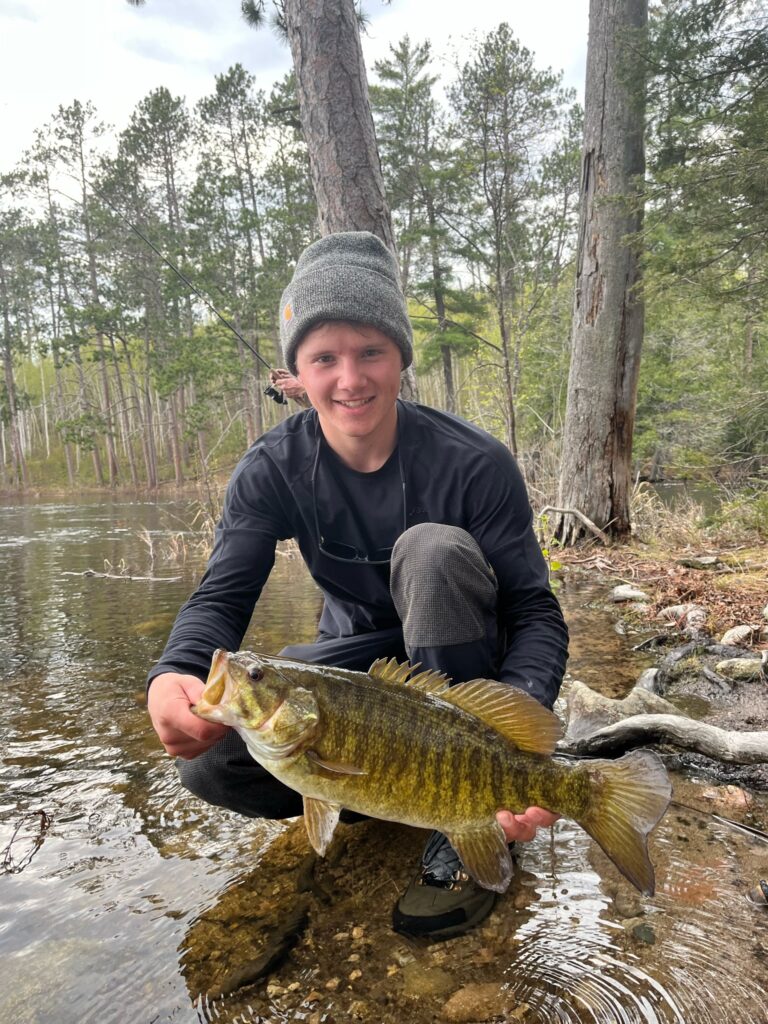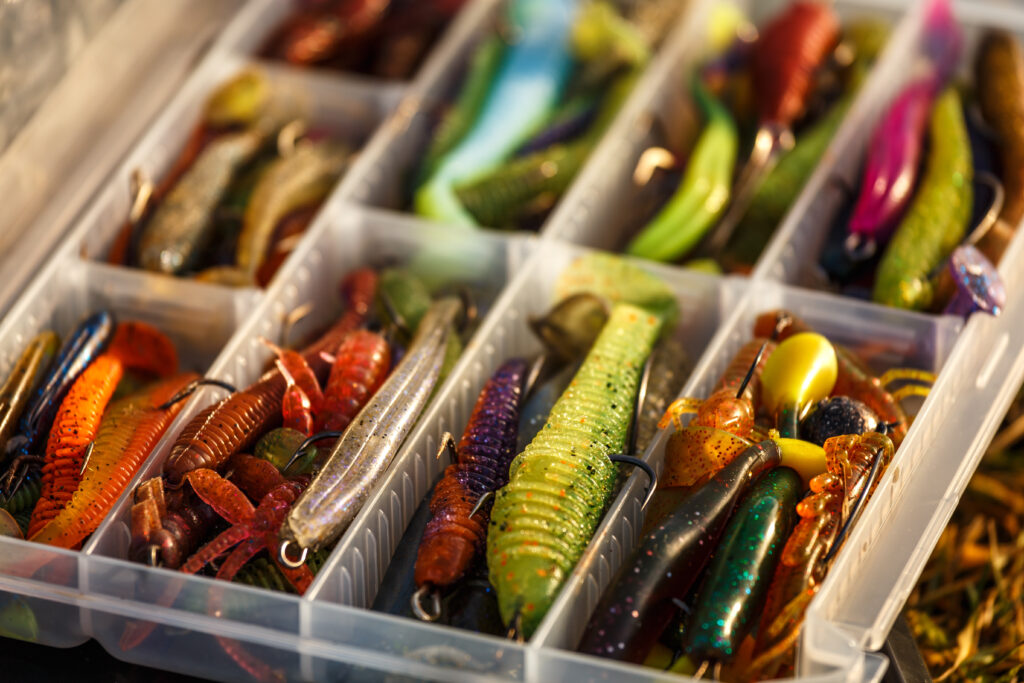Get ready to dive into the exciting world of smallmouth bass fishing in clear water. Having fished smallmouth countless times, I know firsthand the thrill that comes with targeting these feisty fighters. Clear water fishing brings its own set of challenges, but I have you covered! In this guide, I’ll share my tried-and-true techniques to help anglers of all skill levels master the art of catching smallmouth bass in clear water. As always, practice catch and release fishing whenever possible and let’s build a fishing community built around conservation. Let’s get started!
Table of Contents:
- Smallmouth Bass Behavior
- Location
- Gear For Smallmouth Bass
- Soft Plastic Lures
- Suspending Jerkbaits
- Topwater Options
- Stealth is Key
- Presentation Tweaks
- Seasonal Considerations
- Conservation
Behavior of Smallmouth Bass
Smallmouth bass have a special affinity for clear water environments. Smallmouth bass tend to benefit from clear water for its increased visibility. With the introduction of invasives such as zebra mussels and quagga muscles in many smallmouth fisheries, clear water is becoming more and more prevalent. Understanding their behavior and habitat preferences is crucial for a successful fishing trip.
Identifying Prime Fishing Locations
Smallmouth bass like to inhabit rocky structures, drop-offs, submerged points, and humps. Hard bottom is critical for locating smallmouth bass in clear water. On a contour map, hard bottom structures are likely to be the areas where the contour lines are close together. This indicates a steep break which is typical for hard bottom, These areas provide cover for their preferred forage. Smallmouth bass location changes throughout the year, so pay attention to their seasonal habits to stay on fish year round.

Selecting the Right Tackle for Clear Water Smallmouth Bass
Having the right gear can make all the difference when fishing for smallmouth bass in clear water.
Fishing Rods and Reels for Precision and Sensitivity
Opt for medium-light to medium power spinning rods depending on the specific technique you will be using. Having a rod that has enough give is critical when fishing for smallmouth bass with light line and small hooks in clear water. Pair your rod with a high-quality reel that has a smooth drag system. A smooth drag allows you to get away with fishing lighter line which is very important for crystal clear water. Having the correct smallmouth bass rod and reel is more important than ever when fishing clear water.
Fishing Line and Leader Choices For Clear Water
When fishing clear water, either use straight fluorocarbon or braid with a fluorocarbon leader.
In clear water, fish can be skittish and finicky at times. Fluorocarbon lines are nearly invisible underwater, which prevents fish from spooking and increases your chances of getting bites. Thin diameter lines are also essential for the same reason. Consider using a leader for added abrasion resistance when fishing around rocks and other structure.
I recommend using a fluorocarbon leader between 6 lb and 10 lb test for clear water applications. If using braid to a fluorocarbon leader, use at least a 10′ leader length.
Finesse Fishing with Soft Plastic Baits

When smallmouth bass are being finicky in clear water, finesse fishing with soft plastic baits can be the ticket to success.
Drop Shot Rig: Mastering the Suspended Presentation
The drop shot rig is a popular technique in clear water. It involves attaching a weight below the hook and suspending a soft plastic bait above it. Typically, the soft plastic bait is about 1 foot about the weight. However, experimentation with the distance between the weight and the hook can allow you to dial in your drop shot even further. This presentation mimics a slow moving bait fish, and smallmouth bass can’t stand them.
Ned Rig: Subtle Yet Effective
The Ned Rig is another finesse technique that works wonders in clear water. It involves using a small jighead paired with a soft plastic stick bait. Although it seems simple, looks aren’t everything. The subtle movements of the bait are incredibly enticing to smallmouth bass, making them bite when nothing else works.
Bonus Tip: Try adjusting the jig head color when fishing a Ned Rig for smallmouth bass. It varies lake to lakes, but I have found that chartreuse and red are both great jig head colors for smallmouth.
Suspending Jerkbaits for Drawing Reaction Strikes
Suspending Jerkbaits can be effective in clear water situations when you want to trigger reaction strikes from smallmouth bass.
Jerkbaits are versatile lures that mimic an injured baitfish, making them irresistible to smallmouth bass. Jerkbaits excel in clear water since they are a very visual technique. What I mean by this is that smallmouth bass can see them from far distances due to their flash and erratic action. Smallmouth bass in clear water often suspend at specific depths. Use your jerkbait’s diving ability to target these suspended fish and choose a crankbait that dives to the correct depth you will be fishing. Ideally, you want the jerkbait to dive a few feet above where the fish are sitting because smallmouth bass like to feed upwards in clear water.
The key to jerkbait fishing for bass is creating an erratic, injured baitfish action. After casting, twitch your jerkbait down to the desired depth. For the retrieve, use a combination of twitches and pauses. Experiment with the length that you pause the jerkbait for. Sometimes pauses as long as 30 seconds are the ticket in clear and cold water.
Topwater Lures for Exciting Surface Action
There’s nothing quite like the heart-stopping thrill of a smallmouth bass exploding on a topwater lure. Most people think of topwater lures for dirty water, but they work great for smallmouth in clear water as well. Don’t be afraid to throw these topwater lures over deep water as well. Smallmouth are known to chase down lures from long distances in clear water.
Popper and Walker Baits: Mimicking Injured Prey
Popper and walker baits create subtle surface disturbances, imitating injured prey struggling on the water’s surface. With poppers, use a twitch and pause retrieve. With walking baits, use a walk the dog retrieve. Smallmouth bass can’t resist the opportunity for an easy meal, resulting in explosive strikes.
Spybaits: The New Topwater Jerkbait
Spybaits are lures with a minnow profile and propellor on the front and back ends. This lure has gained a lot of popularity recently in the smallmouth bass fishing community and excels when fishing clear water. Spybaits create a subtle commotion on the water’s surface, attracting the attention of smallmouth bass. Retrieve them with a pull and pause retrieve. Keep in mind that you are not twitching your rod as much with this lure, but rather just pulling it a few feet and letting it sit.
The Importance of Stealthy Approaches
In clear water, stealth and precise presentation are key to fooling finicky smallmouth bass. Clear water means fish can see you and your lure more easily. To maximize your chances of success, approach your fishing spots slowly and use your trolling motor on lower speeds. Minimize noise as much as possible to prevent spooking fish.
Casting distance is another key to being stealthy when fishing clear water. Cast your lure as far as possible to create maximum separation between your presentation and the boat. This is where having the right rod and light line comes into play once again.
Perfecting Bait Presentation
In clear water, smallmouth bass can inspect your bait more closely. Choose natural-looking colors and match the hatch. Experiment with different speeds, pauses, and depths to find the presentation that triggers strikes. A lot of people like to resort to slowing down in clear water. This can be effective at times, but don’t be afraid to speed up presentations as well. This prevents smallmouth bass from getting a very good look at the lure and creates more of a reaction strike.
Seasonal Considerations for Clear Water Smallmouth Bass
Understanding how seasonal variations affect smallmouth bass behavior in clear water can boost your success rate.
Spring Tactics: Capitalizing on Pre-Spawn and Spawning Behaviors
In spring, smallmouth bass are often in pre-spawn or spawning mode. Look for shallow areas on rock and sand flats where they build beds. In this cold water, I recommend targeting them with finesse techniques. Ned Rigs and Jerkbaits are key players this time of year.
Summer Strategies: Adapting to Changing Water Conditions
As water temperatures rise, smallmouth bass may move to deeper water offshore. Explore submerged points, humps, drop-offs, and other hard bottom areas near the lakes basin. In the summer, drop shots are popular choices among smallmouth anglers. Additionally, this is the time of year where topwater lures shine.
Fall Approaches: Taking Advantage of Feeding Frenzies
During the fall, smallmouth bass go into a feeding frenzy to bulk up before winter. Smallmouth bass move shallow again, corralling baitfish schools into the backs of bays. Target them near shallow areas with reaction style baits like jerkbaits or topwater lures to mimic the forage they are targeting this time of year.
Conservation and Ethical Fishing Practices

As responsible anglers, it’s crucial to prioritize conservation and practice ethical fishing. Adhere to catch-and-release guidelines whenever possible to preserve the smallmouth bass population for future generations. Handle fish with care, use barbless hooks to minimize injury, and return them to the water as quickly and gently as possible. Respect fish and wildlife habitats by minimizing your impact and leaving the environment as pristine as you found it.
Congratulations, fellow anglers! You’ve now learned how to fish smallmouth bass in clear water. Remember to consider the behavior and feeding habits of smallmouth bass when selecting the right rig for each situation. Experiment, try new things, and don’t be afraid to adapt your techniques based on the conditions you encounter.
